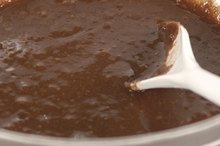Can You Still Get Parasites Once Pork Is Cooked?
Consumption of pork, as with all other meats, can lead to the spread of foodborne illness. The only way to kill parasites in pork is to fully cook the meat. There are a number of precautions available, from the way the livestock is raised to how the meat is prepared and cooked, that will help ensure the meat is rid of parasites.
The Parasites
Taenia Solium, otherwise known as the pork tapeworm, is a parasite that normally attacks the intestine, but can also infect the brain. Symptoms of an infection are usually mild or nonexistant, but can include weight loss, abdominal pain, intestinal obstruction and peri-anal irritation. Toxoplasma gondii causes toxoplasmosis and is the third-leading cause of death from foodborne illnesses, according to the U.S. Department of Agriculture. Trichinella spiralis causes trichinellosis, which begins in the intestinal tract and creates cysts in the muscular system. Each of these parasites can be picked up from consumption of raw or undercooked pork.
Undercooked Pork
The Dangers of Eating Wild Rabbit
Learn More
Fully cooking pork is the only way to ensure all parasites contained within the meat are destroyed. Always use a food thermometer to measure the temperature of cooked meat. Insert the thermometer into the meat while it remains on the cooking heat source, and never taste meat before it has been fully cooked. The Centers for Disease Control and Prevention recommends that ground pork be cooked to 160 degrees Fahrenheit, while whole cuts of pork should be cooked to 145 degrees Fahrenheit. After cooking whole cuts of pork, allow the meat to rest for three minutes before cutting into or eating the meat. According to the USDA, post-cooking rest times are important because the internal temperature of the meat continues to rise or at least remains constant, which helps kill pathogens. The CDC also states that “curing (salting), drying, smoking, or microwaving meat alone does not consistently kill infective worms.” The USDA recommends that pork is heated to 160 degrees Fahrenheit before drying or dehydrating the meat.
Proper Food Handling
Even if a cut of meat is fully cooked, the meat may have contaminated the surfaces used to prepare the meat. Always thoroughly wash all meat grinders, knives, cutting boards and surrounding areas after preparing meat to be cooked. Always wash hands with hot, soapy water after handling any raw meat. As Toxoplasma gondii reproduces in the feline intestinal tract, ensure that any household cats are kept from consuming scraps of raw pork and are kept away from areas that may have been contaminated by raw pork. If a cat is suspected of having come in contact with raw pork, use extra caution, such as handwashing and wearing gloves, when handling the cat’s litter box or working in areas the cat may have used as a litter box, such as the garden. According to the CDC, freezing thin slices of pork for at least 20 days at temperatures at or under 5 degrees Fahrenheit can destroy worms. This guideline does not apply to wild game meats.
Livestock Standards
Can You Get Salmonella from Undercooked Brownies?
Learn More
Raw meats, fecal matter and garbage should never be fed to livestock pigs. Free-range pigs may inadvertently have access to these things and therefore are at a higher risk of carrying parasites. Livestock raised in poor sanitary conditions are also at a high risk. Inappropriate feeding practices and unsanitary living conditions may exist on farms in developing countries; travellers should use caution when buying and preparing pork purchased in these countries. If possible, check the standard of living that livestock has been raised in to avoid eating high-risk pork.
Related Articles
References
Writer Bio
Mary Freeman is a freelance writer. She has held several editorial positions at the print publication, "The Otter Realm." She traveled throughout Europe, which ultimately resulted in an impromptu move to London, where she stayed for eight months. This life experience inspired her to pursue travel writing. Freeman received a degree in human communication from California State University.









